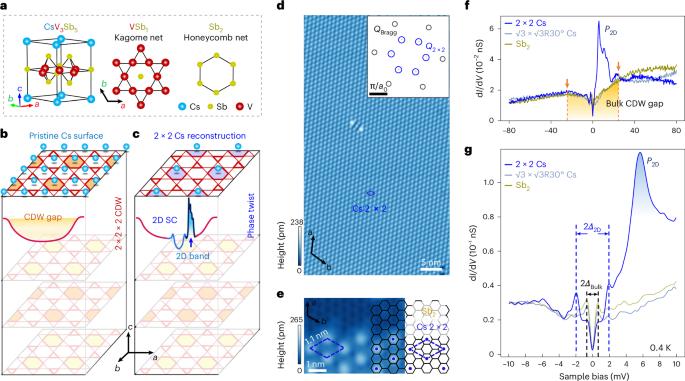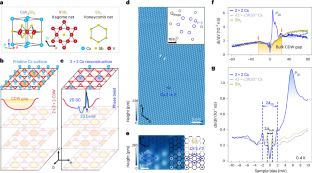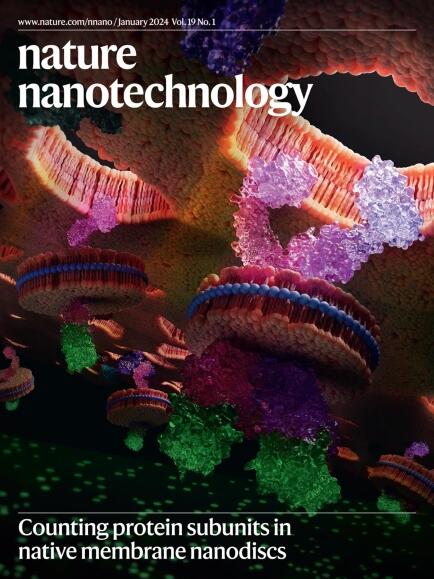Atomic manipulation of the emergent quasi-2D superconductivity and pair density wave in a kagome metal
IF 34.9
1区 材料科学
Q1 MATERIALS SCIENCE, MULTIDISCIPLINARY
引用次数: 0
Abstract
The unconventional charge density wave (CDW) order in layered kagome lattice superconductors AV3Sb5 (A = K, Cs or Rb) triggers the emergence of novel quantum states such as time-reversal symmetry breaking and electronic liquid crystal states. However, atomic-scale manipulation and control of such phases remains elusive. Here we observe the emergent superconductivity and a primary pair density wave at the 2 × 2 Cs reconstructed surface of CsV3Sb5 by means of low-temperature scanning tunnelling microscopy/spectroscopy paired with density functional theory calculations. This quasi-two-dimensional kagome superconducting state with a critical temperature of ~5.4 K is intertwined with the bulk CDW order and exhibits a unique vortex core spectrum and a 4 × 4 pair density wave modulation of the superconducting gap. The emergent phenomena happen at a π-phase-shift dislocation in the periodicity of the CDW along the stacking direction if the 2 × 2 Cs superstructures are out of phase with the bulk CDW. Furthermore, we switched on and off the quasi-two-dimensional superconductivity through tip-assisted atomic manipulation of the 2 × 2 Cs superstructure. Thus, control of the surface reconstruction permits the creation, manipulation and control of quantum many-body states at antiphase boundaries in kagome lattice superconductors and, potentially, in other correlated materials. Scanning tunnelling microscopy experiments uncover a primary pair density wave at the reconstructed surface of the kagome metal CsV3Sb5, and tip-assisted, atomically precise manipulation of the reconstruction provides control over the emergent quasi-two-dimensional superconductivity.


kagome金属中涌现的准二维超导性和对密度波的原子操纵
层状kagome晶格超导体AV3Sb5 (A = K, Cs或Rb)中的非常规电荷密度波(CDW)顺序触发了时间反转对称破缺和电子液晶态等新型量子态的出现。然而,原子尺度的操作和控制这些相仍然是难以捉摸的。本文采用低温扫描隧道显微镜/光谱学方法,结合密度泛函理论计算,观察了CsV3Sb5 2 × 2 Cs重构表面出现的超导现象和一次对密度波。这种临界温度为~5.4 K的准二维kagome超导态与本体CDW序交织在一起,表现出独特的涡旋核谱和超导间隙的4 × 4对密度波调制。当2 × 2cs超结构与块体CDW非相时,在CDW沿堆积方向的周期性中出现π相移位错。此外,我们通过尖端辅助原子操纵2x2cs超结构来开启和关闭准二维超导性。因此,对表面重建的控制允许在kagome晶格超导体的反相边界上创建、操纵和控制量子多体态,并可能在其他相关材料中实现。
本文章由计算机程序翻译,如有差异,请以英文原文为准。
求助全文
约1分钟内获得全文
求助全文
来源期刊

Nature nanotechnology
工程技术-材料科学:综合
CiteScore
59.70
自引率
0.80%
发文量
196
审稿时长
4-8 weeks
期刊介绍:
Nature Nanotechnology is a prestigious journal that publishes high-quality papers in various areas of nanoscience and nanotechnology. The journal focuses on the design, characterization, and production of structures, devices, and systems that manipulate and control materials at atomic, molecular, and macromolecular scales. It encompasses both bottom-up and top-down approaches, as well as their combinations.
Furthermore, Nature Nanotechnology fosters the exchange of ideas among researchers from diverse disciplines such as chemistry, physics, material science, biomedical research, engineering, and more. It promotes collaboration at the forefront of this multidisciplinary field. The journal covers a wide range of topics, from fundamental research in physics, chemistry, and biology, including computational work and simulations, to the development of innovative devices and technologies for various industrial sectors such as information technology, medicine, manufacturing, high-performance materials, energy, and environmental technologies. It includes coverage of organic, inorganic, and hybrid materials.
 求助内容:
求助内容: 应助结果提醒方式:
应助结果提醒方式:


